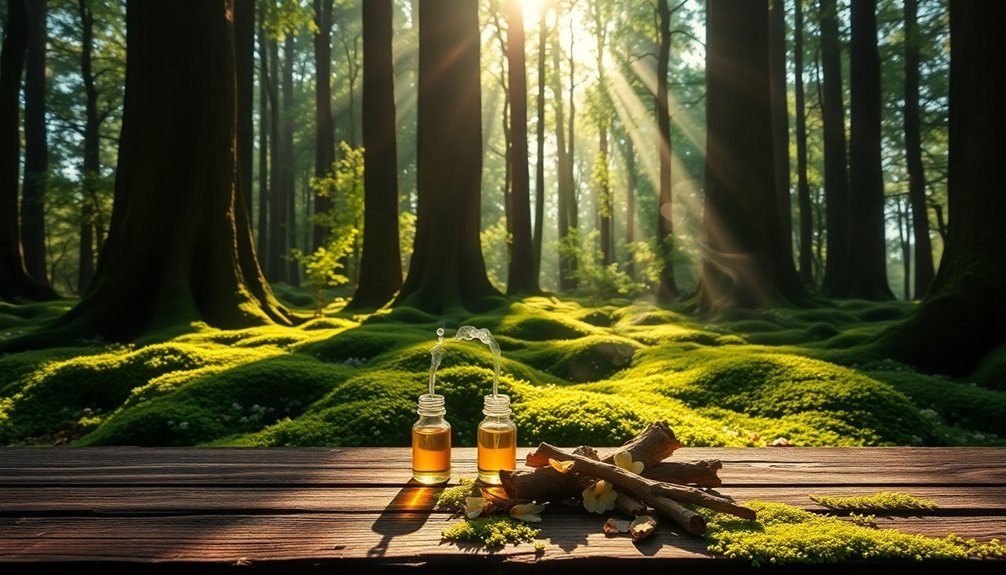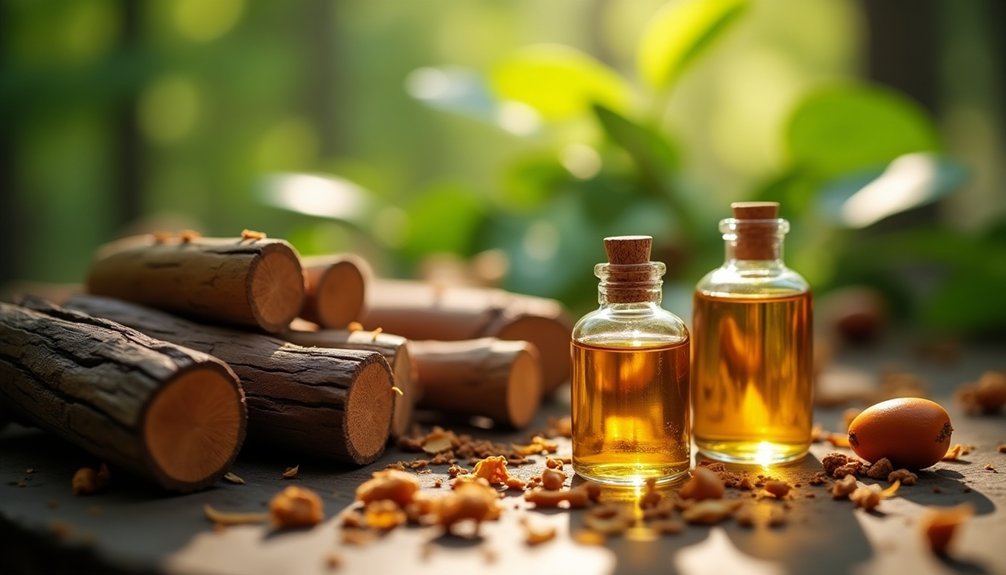Sacred wood recipes offer you time-tested paths to creating enchanting fragrances. You'll discover seven exceptional blends, from the classic Mysore Sandalwood mix with its nutty-creamy profile to the deep, spiritual Eastern Temple accord featuring amyris and cedarwood. Each recipe matures differently, taking two weeks to a month for full development. Whether you prefer traditional or modern approaches, these sacred wood combinations will help you craft perfumes that capture nature's mystical essence. The ancient secrets of these aromatic treasures await your exploration.
Traditional Mysore Sandalwood Blend

The legendary Mysore sandalwood holds a revered position in perfumery, sourced exclusively from India's "Sandalwood City" of Mysore.
You'll find its distinct nutty-creamy aroma sets it apart from other varieties, especially when derived from mature trees aged 80-100 years. Modern perfume oils like creamy sandalwood and nutmeg combinations continue this ancient tradition.
To craft a traditional blend, start with Mysore sandalwood as your base, then layer it with complementary notes.
Add vetiver and rose to extend the base notes, or incorporate citrus for brighter top notes. You can enhance the composition with bergamot or rose geranium for added complexity.
Apply your creation to pulse points like wrists, neck, and behind the ears for ideal diffusion.
For the best results, use aged oils that have developed their full aromatic potential through proper storage.
Eastern Temple Sacred Wood Accord
Sacred temples of the East inspire this complex wood accord, which masterfully blends amyris and cedarwood oils with traditional Mysore sandalwood.
You'll find the spirit of ancient rituals captured through the interplay of myrrh and copahu balsam oil, creating a warm, balmy foundation.
To craft this temple-inspired blend, start with ambrette seed absolute and carrot seed oil for an earthy, spicy opening.
Layer in the woody elements gradually, allowing the amyris to provide its powerful presence while the cedarwood enhances the overall accord.
The distinctive black lacquered bottle design adds an extra touch of luxury to this sacred creation.
Add malted milk vapor for an incense-like lift that elevates the entire composition.
This multi-layered approach mirrors Calice Becker's original creation, bringing together the warmth of spices with the depth of sacred woods in perfect harmony.
Milky Woods With Ambrette Fusion

You'll find that achieving a milky wood accord starts with carefully balancing ambrette seeds against creamy sandalwood and tonka bean notes.
The unique fusion comes alive when you layer skin musk and vanilla to enhance the lactonic qualities while maintaining the wood's natural depth. The luxurious development is enhanced by adding Marshmallow and Benzoin for a comforting warmth that elevates the blend.
To perfect this sacred blend, you'll need to master the proportions of white cedar and mahogany, allowing their distinctive characters to support rather than overwhelm the milky foundation.
Unique Milky Aroma Foundations
When creating milky wood fragrances, mastering the delicate balance of lactonic notes forms the foundation of your perfume's character.
You'll want to start with Gamma-Nonalactone for its creamy, coconut-like aroma, while Delta-Nonalactone adds a subtle nutty dimension with coumarin undertones. For a fresh, watery element, incorporate 6-Decenoic Acid sparingly.
Remember that these lactones are sensitive to environmental factors, so you'll need to store your ingredients properly and formulate with care.
As you build your composition, consider that these milky notes can easily overpower other elements. Start with small amounts and adjust gradually.
Keep in mind that your goal isn't just to create a milky scent, but to craft a harmonious blend where each note complements the others without domination.
Scent Fusion Balancing Techniques
Mastering the fusion of milky woods with ambrette requires a thoughtful understanding of fragrance families and their interactions.
You'll want to start by recognizing their shared musky and amber notes, which create a natural harmony between these scents.
When blending, apply your fragrances from lightest to heaviest. Start with a small amount of milky woods, allowing its woody base notes to settle on your skin.
Then, layer ambrette carefully to add depth and sensuality. If you find milky woods is more potent, let it settle before adding the ambrette.
Trust your instincts as you experiment with proportions. The goal is to create a balanced composition where the warm, comforting qualities of milky woods complement ambrette's complex, sensual character.
Use a fragrance primer to help your scents blend seamlessly and last longer.
Spiced Carrot and Balsam Creation
Creating a spiced carrot and balsam perfume combines traditional aromatherapy with modern cocktail-inspired elements.
You'll need to start with a carrier oil base of either fractionated coconut oil for roll-ons or sweet almond oil for solid formulations. The magic happens when you blend your essential oils, carefully balancing the woody balsam fir with orange's bright citrus notes and patchouli's earthy depth.
- Heat your carrier oil with candelilla wax to 104°F if making a solid perfume.
- Add 20-40 drops of essential oils per ounce, starting with top notes.
- Incorporate carrot syrup or carrot seed oil for a unique signature.
- Let your creation mature for two weeks in a cool, dark place.
Remember to perform a patch test before applying your perfume, and store it properly to maintain its aromatic integrity.
Sacred Myrrh and Cedarwood Elixir

The sacred blend of myrrh and cedarwood offers a profound spiritual connection rooted in ancient traditions and temple worship.
To craft this divine elixir, you'll need 4 drops each of myrrh and cedarwood essential oils, complemented by 6 drops of frankincense and 12 drops of vanilla for depth and sweetness.
Begin by combining your essential oils in a dark glass bottle, then fill it with jojoba or sweet almond oil as your carrier. You can add a splash of alcohol base to help the scents meld together.
For added complexity, consider incorporating other base notes like sandalwood or vetiver.
Remember to store your creation in a cool, dark place and always perform a patch test before use.
Allow your blend to mature for a month, letting the sacred scents harmonize into a truly remarkable perfume.
Amyris-Centered Wood Composition
While sandalwood commands premium prices in perfumery, Amyris oil offers a budget-friendly alternative with its own enchanting characteristics.
You'll discover a soft, woody aroma with vanilla and balsamic undertones that can transform your perfume creations. This pale yellow oil from the Caribbean region acts as an excellent fixative, helping your fragrances last longer.
To create your own Amyris-centered wood composition:
- Start with Amyris as your base at 20% of the total composition
- Blend with Cedarwood and Guaiacwood (10% each) for depth
- Add a touch of Rose or Ylang-Ylang (5%) for floral complexity
- Finish with Bergamot (5%) for a bright top note
Remember to perform a skin test before use, as this composition may cause irritation in some individuals.
Balmy Woods With Copahu Essence

Sacred rituals from the East inspire this luxurious blend centered around Copahu Balsam oil. You'll find the warm, incense-like qualities of myrrh perfectly complement the balmy essence, while Mysore sandalwood adds its coveted woody depth to the composition.
To create this aromatic masterpiece, combine cedarwood with Amyris oil for a rich woody foundation. Layer in Ambrette seed absolute and carrot seed oil to introduce earthy, spicy elements that enhance the blend's complexity. The addition of malted milk vapor brings an unexpected creamy dimension that ties everything together.
For additional depth, you can incorporate complementary ingredients like agarwood or guaiacwood. These elements will strengthen the velvety, smoky qualities while maintaining the fragrance's balmy character.
The result is a sophisticated woody blend that honors ancient perfumery traditions.
Frequently Asked Questions
How Long Does Homemade Sacred Wood Perfume Typically Last Before Expiring?
Your homemade sacred wood perfume will typically last 3-5 years after opening if you store it properly. When it's unopened, it can last even longer – up to several years or decades in ideal conditions.
Can Synthetic Alternatives Effectively Replace Rare Mysore Sandalwood in These Recipes?
Yes, you can effectively use synthetics like Sandalore or Javanol to replace Mysore sandalwood. They'll provide similar woody notes, though you'll need to adjust concentrations carefully as they're more powerful than natural materials.
What Safety Precautions Should Be Taken When Working With Sacred Wood Oils?
You'll need protective gloves, ventilation, and proper storage in dark glass bottles. Don't inhale vapors directly, test for allergies first, and keep oils away from children. Always clean spills with non-combustible materials.
Are There Specific Temperature Requirements for Storing Sacred Wood Perfume Ingredients?
You'll want to store sacred wood ingredients at room temperature in a cool, dark place. While refrigeration isn't required, keeping them away from heat and sunlight will preserve their quality and fragrance properties.
Which Carrier Oils Work Best for Diluting Sacred Wood Perfume Concentrates?
You'll get the best results using grapeseed oil as your primary carrier, thanks to its quick absorption and neutral scent. You can also blend it with jojoba oil for enhanced skin compatibility.
In Summary
You've now learned seven unique recipes combining sacred woods into enchanting perfumes. Whether you're drawn to the classic Mysore sandalwood or prefer the exotic Copahu essence, these formulas will help you create rich, spiritual fragrances. Start with small batches, trust your nose, and don't be afraid to adjust proportions. With practice, you'll master the art of blending these precious woods into personal signature scents.





Leave a Reply